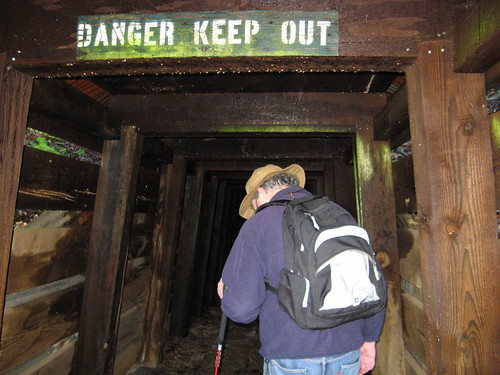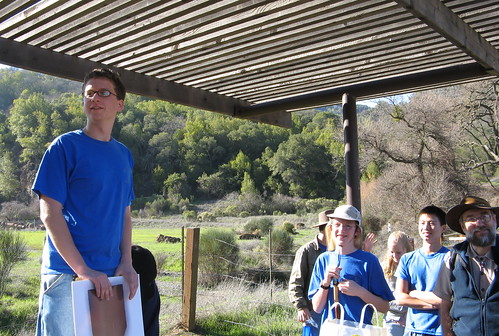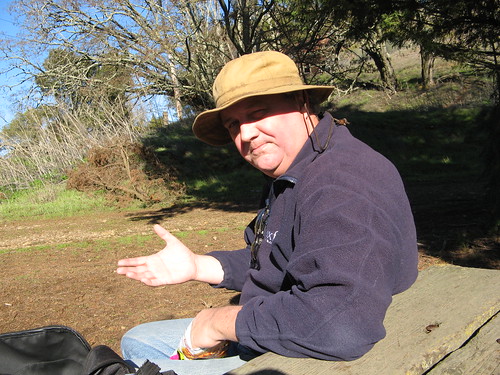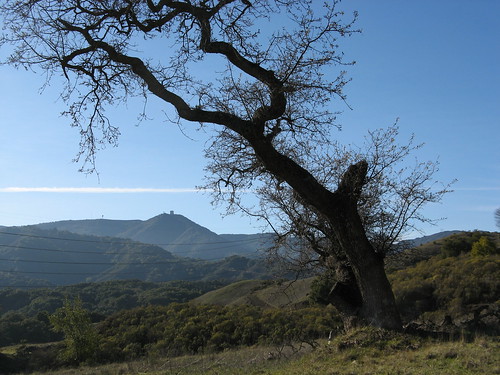“I never knew any of this was back here,” Zack the Eagle Scout says.
We’re at Alamaden Quicksilver County Park, the site of what used to be a massive mercury-mining operation with shafts and tunnels bored all over the hills of south San Jose. Zack, his dad and a couple dozen Scouting types from Sunnyvale Troop 466 (“The Eagle Makers”) are gathering at the Hacienda Entrance to the park, waiting the arrival of one Mike Malone, an Eagle Scout of 1960s vintage who grew up to be a writer, journalist, high-tech pundit and most important of all for our purposes, the assistant scoutmaster who did know all this was back here.
I explain to Zack’s dad that I work as an editor at the paper and the natural state of things is for a writer to be late, and an editor to be waiting for said writer. So, I feel right at home (well, work).
That’s Zack on the left. He has the easy self-assurance of somebody you know will run the world in the later stages of his adulthood. With guidance from “Mr. Malone,” Zack researched the mining history of Almaden Quicksilver and developed a hiking route that connects most of the old mining sites at the park. He put together a brochure with turn-by-turn descriptions of where to go and what to see (mostly rusting ruins, but still pretty cool), and his troop installed numbered posts for all the attractions.
Malone’s oldest son’s eagle project is just a bit more ambitious — a venture capitalist-funded portable computer lab being shipped to Zambia — but he did have this idea that Scouting ought to have more “history hikes,” and he hopes to help Scouts put together similar routes up and down the Santa Cruz Mountains.
Here’s Mr. Malone, pundit, author, Assistant Scoutmaster. Awhile back he took a bunch of Scouts hiking in the rain across England. Soon, he’d like to take them on a cattle drive in Oklahoma. Mike’s not given to small thoughts. (Here’s a page of his accomplishments … the perfect place to ask him, “So, Mike, what do you do?” is on a six-mile hike, which provides almost enough time for his reply).
Here’s one of the posts they sunk in the rocky soil. Up the trail a ways they noticed that two of the posts didn’t match the numbers on their brochures, of which several thousand were already in print. So, they sawed the tops off the two offending posts and swapped the tops by reattaching them with glue and screws. That’s the can-do spirit of flexibility that built Silicon Valley, I’m here to tell you.
Here’s the famous Hanging Tree, where the miners of yore allegedly inflicted quick justice.
This is a younger Scout also named Zachary who was hiking with us. He’s thinking of organizing a cleanup along the Guadalupe River for his Eagle service project. I was in Scouts for the camp-outs until about the eighth grade, but I had to bail because I knew that sooner or later they’d expect me to volunteer for one of these service projects, and I had much more important adolescent goofing off planned.
That big rock next to him is one the miners brought in from the Sierra for spike-driving contests. These were not men you would’ve wanted to arm wrestle without an orthopedic surgeon nearby (especially given that in those days, orthopedic surgery usually meant amputation).

There is one short stretch of tunnel hikers can walk into. The rest have all been sealed off.
The blue T-shirts are much better for hiking than those 1920s-vintage military knock-offs they wanted Scouts to wear back in the day.
So those are the highlights of Sunday’s walk. If you go to Almaden Quicksilver, these history hike brochures should be tucked into those boxes at the trail board. They’re trimmed in brown with old-fashioned type and fold out to a pretty large size.







Tom, I finally did this hike. It was pretty cool. I found one of the swapped off top #3, what was the other one?
Ann: I’m not sure what the other one was. Forgot to ask.